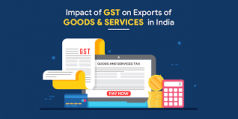In India, the GST for the export of goods and services is zero-rated. Here, a zero-rated supply does not suggest that the goods and services have a tax rate of zero percent.
The goods and services tax has a major effect on Indian exports, as many of the revenue issues are economically relevant. Following the launch of the goods and services tax, it was reported that the sector managed to collect revenue and capital issues during the first month of implementation. And now almost three months after the spread of GST, the export industry is apparently facing a tough time due to the lack of prompt refunds.
It was agreed at the 22nd GST Council meeting at the latest that six-month tax concessions would be available for exporters. It is also determined that for the months of July and August, returns would be refunded by review on 10 and 18 October respectively. Exporters are also exempt from high tariffs, creating 0.1% of the excluded tariff.
The major objective of the Government of India is to increase the production and productivity of exports from India and the various tax benefits given to exporters. On 1 July, GST was adopted, and yet there may still be some ambiguity among the exporters as to the feasible impact of the new scheme on this undertaking. Traders may like to know how GST would affect the products sold and the amount of tax paid on the raw material/input used. The Government of India has also exchanged notices and recommendations with the public about the applicability of CGST, SGST, UTGST, Cess, and GST prices to clear this misunderstanding. In this article, we will learn How GST Impact Export of Goods and Services – Explained
How to apply GST on shipments of goods and services
According to the previous regulations, in lieu of the duty charged on goods for the selling of the exempted products, a tariff drawback was provided. Claiming the downside of duty turned into a major activity. In the GST, only customs duties imposed on imported inputs or on central excise duty charged on petroleum or tobacco products used as inputs or as fuel for captive power generation will be subject to the drawback of customs duties. There was, however, confusion regarding the refund of the input tax paid by the exporters.
Therefore in relation to the above-mentioned problem, the Government of India released a notice which helped to address concerns concerning the assertion of an input tax credit (ITC) on zero-rated exports. An exporter trading in GST zero-rated goods can under the following options, request a refund for zero-rated supplies, as follows:
1 This includes the procurement of goods or services, or both, under a bond or a letter of undertaking (LUT), in compliance with the terms, precautions, and procedures that may be needed, without charge of the tax involved and therefore, the refund of unused input tax credits. The exporter is expected to request an application for a refund at the popular GST location, either directly or through the Facilitation Center of the GST Commissioner. The export manifest or documents shall be given pursuant to the Customs Act until the claim for refund has been filed.
2. Any exporter or any United Nations or Ambassador or other individual or entity referred to in Section 55 that supplies products or services, or both in accordance with such terms, precautions and procedures as may be required and payable by the IGST may request that the tax paid on the goods or services supplied, or both, be refunded. The complainant is required to apply for a refund in accordance with the detailed conditions set out in Section 54 of the CGST Act.
What The Documents Required to Demand Export Refunds
- Below is a list of important documentation required to seek a refund:
- A return copy which provides evidence of the payment of the obligation.
- And a copy of the bill.
- Any documents showing that the duty to pay tax has not been passed on, such as CA registration or self-certification.
- Any other document that is required by the Government of India.
Labor-Intensive Industries Effect of GST
It noted that the labor-intensive industry after GST introduction was deteriorating, including ready-made clothes, gems and jewelry, carpets, and pharmaceuticals. Although arriving at the exact figures, a 40 percent direct decrease in the production of handmade carpets was seen in the month of July as a comparison of the data shipments from the previous year. Both this resulted due to the complicated documentation introduced for the first time in the industry and the rigid compliance-based text framework. Mr. Mahavir Sharma, Chairman of the Promotion Council for Carpet Export, said We are getting price resistance from U.S. importers as they are worried about the price increase that will be passed on to them In the history of exports, India managed a total of INR 10000 crores of handmade carpet exports last year.





